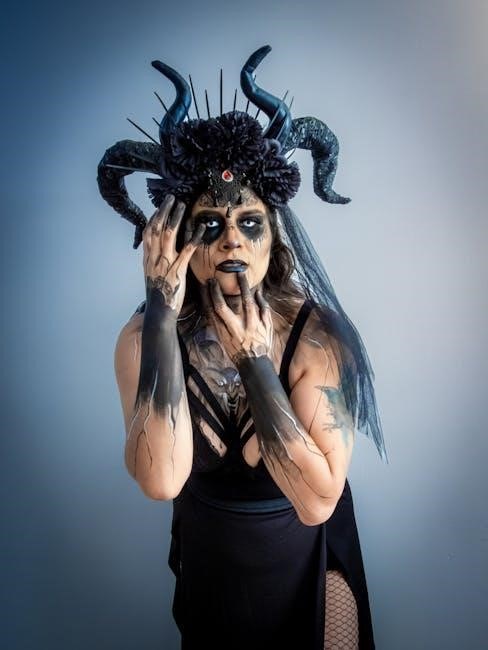Deities & Demigods is a seminal Dungeons & Dragons sourcebook, offering detailed insights into divine beings, pantheons, and cosmology. First published in 1980, it remains a cornerstone for players and Dungeon Masters, providing rich lore and gameplay mechanics centered around deities and their influence. The book has undergone multiple editions, with the first printing notably including content from the Cthulhu Mythos and Melnibonéan series, which were later removed, making it a sought-after collectible. It serves as both a narrative resource and a rulebook, enhancing the depth of D&D campaigns with its expansive exploration of divine entities and their roles in the game world.
1.1 Overview of the Book
Deities & Demigods is a comprehensive sourcebook for Dungeons & Dragons, detailing divine entities, pantheons, and cosmological structures. It explores the roles of gods, demigods, and their influence on the game world, offering both narrative depth and mechanical rules. The book covers a wide range of mythologies and fictional universes, including the Cthulhu Mythos and Melnibonéan series in its first edition. Later editions removed some content due to licensing issues, but the book remains a vital resource for players and Dungeon Masters seeking to integrate divine elements into their campaigns. Its detailed descriptions and gameplay mechanics make it a cornerstone of D&D lore and customization.
1.2 Importance in Dungeons & Dragons
Deities & Demigods holds a revered place in Dungeons & Dragons as it expands the game’s scope by introducing divine entities and their influence. It provides players with a deeper understanding of the cosmos and the roles of deities, enabling richer character creation and world-building. For Dungeon Masters, the book offers tools to craft immersive narratives and divine interactions. Its inclusion of pantheons and mythologies enhances the game’s versatility, making it a cornerstone for both players and creators. The book’s influence is evident in later editions, solidifying its legacy as a foundational resource for D&D enthusiasts. Its content remains timeless, shaping the game’s divine mechanics and lore.
1.3 Brief History of Publication
Deities & Demigods was first published in 1980 by TSR Inc. as a supplement for Advanced Dungeons & Dragons. The initial printing famously included sections on the Cthulhu Mythos and the Melnibonéan pantheon from Michael Moorcock’s Elric series, which were later removed due to licensing issues. These omissions made the first edition highly sought after by collectors. Subsequent printings adjusted the content, but the book’s core concept of detailing divine beings and their roles in the D&D universe remained unchanged. Its publication marked a significant expansion of the game’s lore and mechanics, solidifying its place as a foundational resource for players and Dungeon Masters alike.
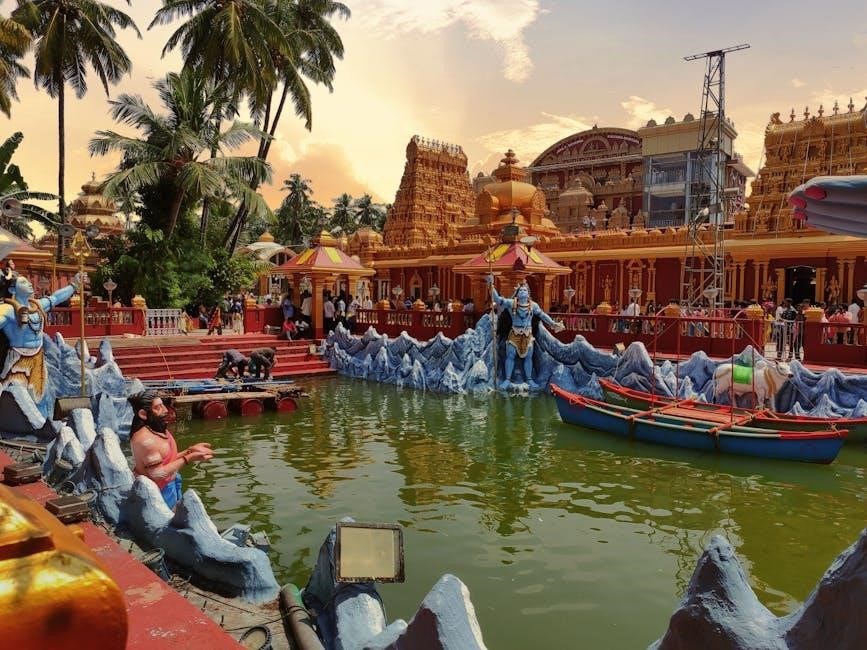
Historical Background of Deities & Demigods
Deities & Demigods was first published in 1980 by TSR Inc., becoming a cornerstone of Dungeons & Dragons lore. It introduced divine beings from various mythologies, enriching the game’s universe.
2.1 First Edition Details
The first edition of Deities & Demigods was published in 1980 by TSR Inc. and served as a foundational resource for Dungeon Masters. It introduced a wide array of deities, demigods, and divine entities drawn from various mythologies, including Greek, Norse, and Egyptian pantheons; Notably, the first printing included sections on the Cthulhu Mythos and the Melnibonéan series by Michael Moorcock, which were later removed due to copyright issues. These inclusions made the first edition highly unique and collectible among D&D enthusiasts. The book laid the groundwork for integrating divine lore and mechanics into the game, significantly expanding its narrative depth.
2.2 Later Printings and Changes
Later printings of Deities & Demigods saw significant changes, particularly the removal of the Cthulhu Mythos and Melnibonéan sections due to copyright concerns. These omissions made the first edition highly sought after by collectors. Subsequent editions focused more on traditional mythologies and streamlined divine mechanics. The book’s content was adapted to align with evolving D&D rules, ensuring compatibility with newer editions while maintaining its core purpose of enriching campaigns with divine lore. These changes reflected the dynamic nature of D&D’s development and its responsiveness to both legal and community feedback.
2.3 The Cthulhu Mythos and Melnibonéan Sections
The first printing of Deities & Demigods uniquely included sections on the Cthulhu Mythos and Melnibonéan mythologies, drawn from H.P. Lovecraft and Michael Moorcock’s works. These sections introduced entities like Cthulhu and Elric, blending cosmic horror and dark fantasy into the D&D universe. However, due to copyright issues, these sections were removed in later printings, making the first edition highly collectible. Their inclusion added a layer of complexity, appealing to fans of both fantasy and horror, and remains a fascinating footnote in the book’s legacy, showcasing its early experimentation with diverse mythological influences.
Content and Structure of the Book
Deities & Demigods is structured into detailed sections, exploring pantheons, divine hierarchies, and demigods. It organizes content logically, providing lore, stats, and rules for integration into D&D campaigns seamlessly.
3.1 Pantheon of Deities
Deities & Demigods presents a vast array of divine beings from various mythologies and fictional universes. It includes detailed descriptions of major deities such as Zeus, Odin, and Ra, along with lesser-known figures. Each deity is fleshed out with attributes, domains, and influence, offering players and DMs rich material for character creation and world-building. The pantheon section also draws from literary sources, featuring gods from the Cthulhu Mythos and Michael Moorcock’s Elric series, though some were removed in later editions. This diversity allows for immersive storytelling and enhances the game’s depth by connecting characters to powerful cosmic forces.
3.2 Demigods and Their Roles
Demigods in Deities & Demigods serve as powerful intermediaries between mortals and gods, often embodying specific aspects of divine influence. They are typically depicted as lesser deities or heroic figures with extraordinary abilities, capable of influencing events on both mortal and divine planes. These beings can act as patrons, allies, or adversaries, offering unique opportunities for character development and plot integration. The book details their roles in pantheons, their interactions with mortals, and their significance in shaping world lore, providing depth and complexity to campaigns. This section enriches gameplay by expanding the range of divine interactions beyond major deities.
3.3 Cosmology and Divine Hierarchies
Cosmology and Divine Hierarchies in Deities & Demigods explore the structure of the multiverse and the organization of divine power. The book details how deities fit into broader cosmic frameworks, influencing worlds and planes. Divine hierarchies are explained, showing how gods and demigods rank and interact within pantheons. This section also covers the roles of supreme deities, lesser gods, and their relationships with mortals. The text provides a rich narrative foundation for understanding the divine order, enabling players and Dungeon Masters to integrate cosmic themes and divine Intervention seamlessly into campaigns. This depth enhances the immersive quality of the game world.
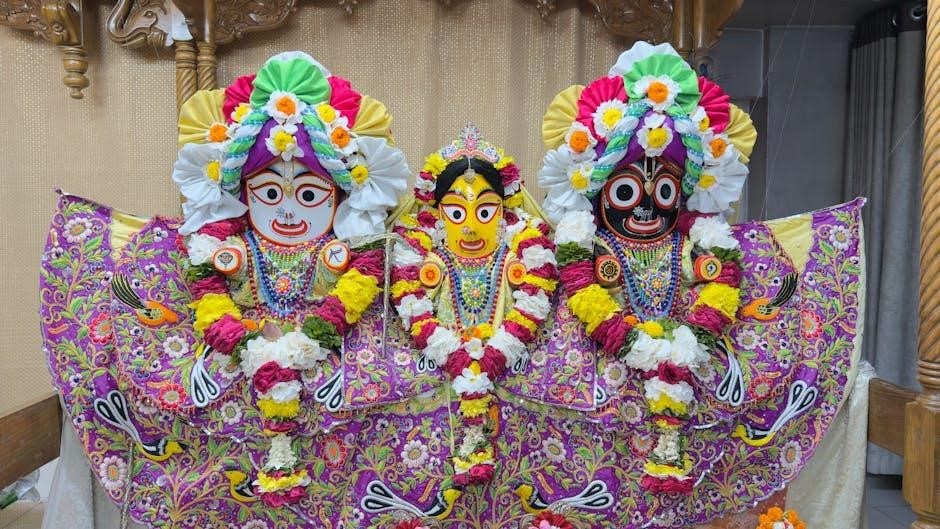
Gameplay Mechanics Involving Deities
Deities & Demigods introduces mechanics for divine magic, cleric spellcasting, and worship systems. It details how deities influence the game through avatars, divine intervention, and sacred quests, enhancing gameplay depth.
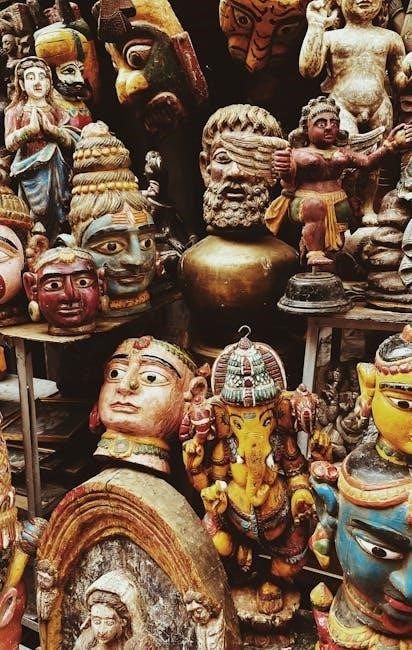
4.1 Clerics and Divine Magic
Clerics serve as divine emissaries, channeling their deities’ power to perform miracles and wield sacred magic. Deities & Demigods provides detailed mechanics for cleric spellcasting, including divine spell preparation, domains, and holy symbols. Clerics derive their abilities from their faith, with spells powered by prayer and divine favor. The book outlines how clerics can summon divine aid, heal wounds, and protect allies, emphasizing their role as intermediaries between mortals and gods. This section also explores the influence of a cleric’s chosen deity on their abilities, adding depth to character creation and gameplay through divine specialization and sacred duties.
4.2 Worship and Divine Influence
Worship and divine influence are central to the dynamics of Deities & Demigods, shaping both character interactions and world-building. The book details how followers honor their deities through rituals, prayers, and offerings, influencing divine favor. Holy symbols and sacred texts are emphasized as tools for channeling divine power. The strength of a deity’s influence often correlates with the number of devoted followers, creating opportunities for powerful events or divine intervention. This section also explores how worship impacts clerics, with their actions reflecting their deity’s will, and how collective devotion can shape the game world, adding depth to both role-playing and mechanics.
4.3 Avatars and Divine Intervention
Avatars and divine intervention are pivotal elements in Deities & Demigods, allowing deities to manifest their power directly in the mortal realm. Avatars serve as physical embodiments of divine will, often intervening in critical events or aiding devoted followers. Divine intervention can take many forms, from subtle miracles to catastrophic events, and is influenced by the deity’s influence and the devotion of their followers. The book provides rules for how avatars function in gameplay, including their abilities and limitations, while also emphasizing the narrative potential of divine interference. This mechanic adds depth to storytelling and creates opportunities for dramatic, godly involvement in campaigns.
Notable Deities and Demigods
Deities & Demigods introduces a vast array of divine beings, from major gods like Pelor and Loki to demigods and heroes. It also features unique entities from mythos and fiction, enriching the D&D experience with diverse lore and gameplay mechanics.
5.1 Major Deities from Various Mythologies
Deities & Demigods features a diverse pantheon of major deities drawn from various mythologies, including Pelor, Loki, Athena, and Osiris. These divine beings are central to shaping the game’s cosmology and influencing characters. Clerics often derive their power from these gods, whose domains reflect their mythological roles. The book also incorporates deities from literature, such as Cthulhu Mythos entities and Melnibonéan beings, adding unique flavor to campaigns. These deities not only serve as powerful figures but also shape the world’s lore, providing rich narrative opportunities for both players and Dungeon Masters to explore.
5.2 Demigods and Heroes in the Book
Deities & Demigods also highlights demigods and legendary heroes, blending mythological and literary figures. Characters like Elric of Melniboné and Fafhrd and the Gray Mouser from fantasy literature are featured alongside mythological heroes such as Hercules. These figures often serve as inspirations or adversaries, adding depth to campaigns. Their stories and abilities provide players with rich narrative hooks, while Dungeon Masters can use them to craft compelling quests or encounters. The inclusion of these iconic beings bridges mythology and fiction, enriching the game’s lore and offering diverse character archetypes for players to emulate or interact with. Their presence enhances the immersive storytelling potential of D&D.
5.3 Unique Beings from Fiction and Mythos
Deities & Demigods introduces unique beings from both fiction and mythos, enriching the D&D universe. The first printing notably included deities from the Cthulhu Mythos and Melnibonéan series, such as Great Old Ones and Elric’s pantheon. These sections, later removed, added cosmic horror and dark fantasy elements, making early editions highly sought after. These beings offer diverse narrative possibilities, bridging mythologies and fictions. Their inclusion enhances the game’s depth, allowing for intricate storytelling and encounters that blend terror and wonder, providing players and Dungeon Masters with a wealth of inspiration for unique campaigns.
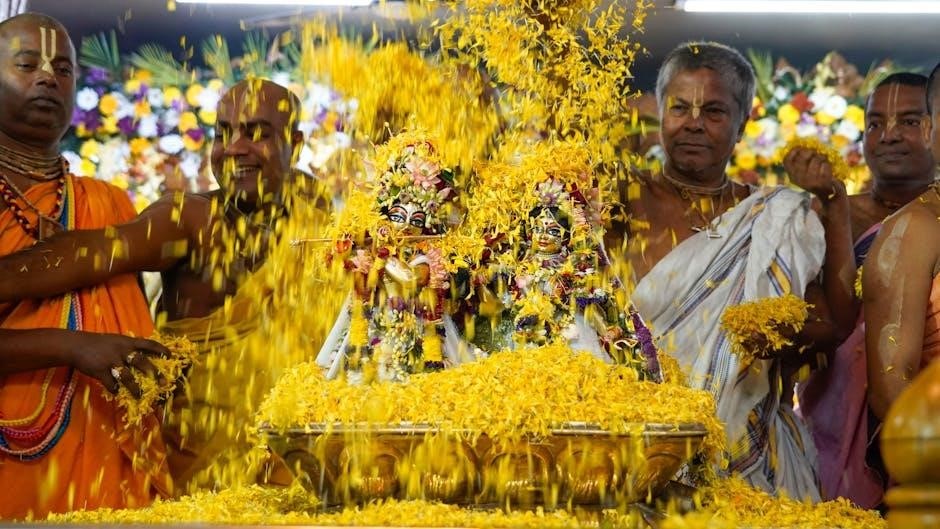
Cultural and Mythological Influences
Deities & Demigods draws from diverse cultural and mythological sources, blending real-world mythologies with literary influences to create a rich tapestry of divine lore and cosmology.
6.1 Real-World Mythologies Adapted
The Deities & Demigods sourcebook extensively adapts real-world mythologies, incorporating deities from Greek, Norse, Egyptian, and other pantheons. These divine beings are reimagined within the D&D framework, preserving their mythological essence while integrating gameplay mechanics. Players and Dungeon Masters can draw upon these mythologies to craft unique clerics, divine magic, and worship systems. The inclusion of these pantheons enriches campaigns with cultural depth, allowing for immersive storytelling and character development rooted in historical mythologies. This adaptation showcases the book’s ability to bridge traditional lore with fantasy role-playing, enhancing the D&D experience.
6.2 Influence of Literature on the Book
Literary works significantly influenced Deities & Demigods, particularly through the inclusion of fictional pantheons. Notably, Michael Moorcock’s Elric series and H.P. Lovecraft’s Cthulhu Mythos were featured in early editions, adding unique cosmic horrors and mythical depth. These literary adaptations expanded the book’s scope, blending fantasy and horror elements. However, due to copyright issues, these sections were removed in later printings. The integration of such iconic literary elements showcased the book’s ability to draw from diverse narrative traditions, enriching its content and appealing to fans of both mythology and literature. This literary influence remains a standout feature of its early editions.
6.3 Cultural Significance of the Content
The content of Deities & Demigods holds profound cultural significance, as it unites diverse mythological traditions into a cohesive framework. By adapting real-world pantheons and fictional mythos, the book bridges cultural gaps, offering players a rich tapestry of divine narratives. Its inclusion of deities from various global mythologies not only educates but also fosters appreciation for different cultural heritages. Additionally, the book’s ability to weave these elements into the D&D universe has made it a cornerstone of fantasy gaming culture, influencing countless campaigns and inspiring creative interpretations of mythology in modern media and storytelling.
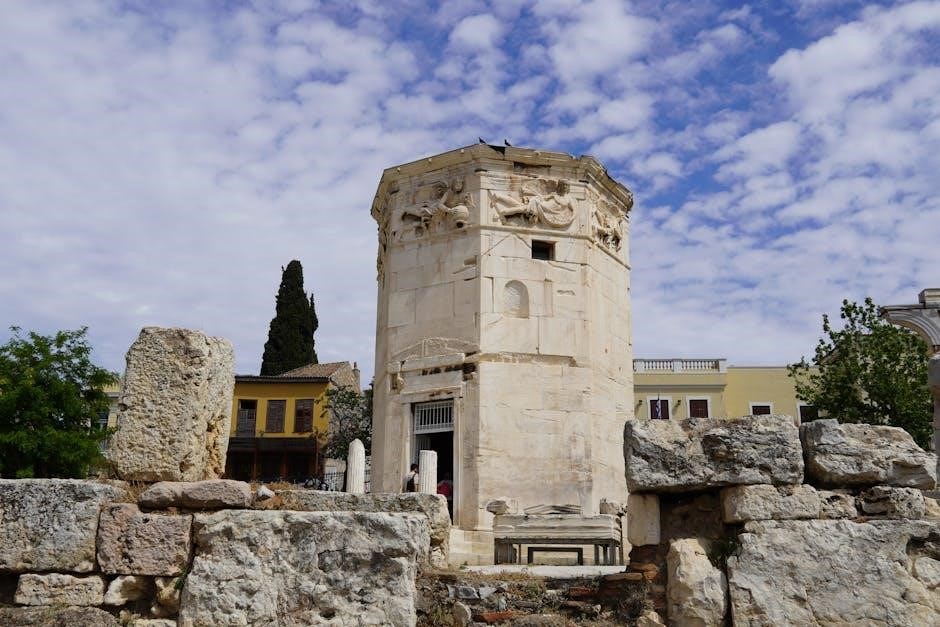
Legacy and Impact of Deities & Demigods
Deities & Demigods has left a lasting impact on D&D, shaping its lore and mechanics. Its inclusion of diverse pantheons and mythos expanded the game’s scope, making it highly collectible and influential for later editions and supplementary materials.
7.1 Influence on Later Editions of D&D
Deities & Demigods laid the groundwork for divine mechanics in later D&D editions. Its pantheon system inspired the 3.5 Edition’s divine magic framework and influenced books like Complete Divine. The 5th Edition’s handling of gods in Mordenkainen’s Tome of Foes reflects its legacy. By integrating mythological and fictional deities, it set a precedent for blending real-world and fantasy elements, making it a foundational text for modern D&D’s cosmic and theological depth. Its impact is evident in how later editions expanded cleric classes and divine lore, ensuring its relevance in shaping the game’s spiritual and narrative dimensions.
7.2 Popularity and Collectibility
Deities & Demigods remains highly popular and sought after by collectors and players. Its first printing, featuring the Cthulhu Mythos and Melnibonéan sections, is particularly valuable due to later printings removing these elements. The book’s unique blend of mythology and fantasy has cemented its status as a classic, with many enthusiasts actively seeking physical copies. Online marketplaces often list it at premium prices, reflecting its demand. Additionally, its influence on modern D&D ensures its relevance, making it a treasured resource for both gameplay and historical insight into the evolution of the game. Its collectibility endures as a testament to its enduring legacy.
7.3 Modern Relevance in Gaming
Deities & Demigods continues to hold significant relevance in modern gaming, particularly among Dungeons & Dragons enthusiasts. Its detailed pantheons and divine mechanics inspire players and Dungeon Masters alike, offering rich lore for character creation and world-building. The book’s influence is evident in later editions, with many of its concepts adapted and expanded upon. Additionally, its content on divine magic and cosmology remains a valuable resource for crafting immersive campaigns. Even with newer sourcebooks available, Deities & Demigods is often sought for its unique blend of mythology and fantasy, making it a timeless classic in the D&D community. Its legacy endures as a foundational text for both gameplay and narrative design.
Legal and Copyright Information
Deities & Demigods is copyrighted by Wizards of the Coast, with original editions published by TSR. Early printings included Cthulhu Mythos content, later removed due to licensing.
8.1 Copyright Status and Editions
Deities & Demigods is copyrighted by Wizards of the Coast, with earlier editions originally published by TSR. The first edition, released in 1980, included content from the Cthulhu Mythos and Melnibonéan series, which were later removed due to licensing issues. Subsequent editions adapted the material to align with D&D’s evolving intellectual property policies. Digital versions are available through official platforms like DriveThruRPG, ensuring accessibility while maintaining copyright compliance. The book remains a protected work, with its content reserved for use within the bounds of Wizards of the Coast’s licensing agreements.
8.2 Digital Availability and Downloads
Deities & Demigods is widely available in digital formats, with PDF versions accessible through platforms like DriveThruRPG and DMs Guild. The 1st edition and later printings, excluding the Cthulhu and Melnibonéan sections, can be downloaded for personal use. Digital versions often include searchable text and bookmarked sections, enhancing usability. Some platforms offer free previews, while others require purchase. Additionally, community-driven repositories and forums may share links, though users should ensure compliance with copyright laws. Digital availability has made the book more accessible, catering to both veteran players and newcomers exploring D&D lore and mechanics.
8.4 Legal Considerations for Players
Players must respect copyright laws when accessing Deities & Demigods PDFs. The book’s content, especially sections like the Cthulhu Mythos and Melnibonéan, was removed in later editions due to copyright disputes. Ensuring that downloads are from authorized platforms like DriveThruRPG or DMs Guild is crucial. Sharing or distributing pirated copies is illegal and undermines creators. Always verify the source and legality of the PDF to avoid potential legal consequences. Respecting intellectual property ensures the longevity of such resources for the D&D community. Legal compliance supports both the game’s legacy and future development.
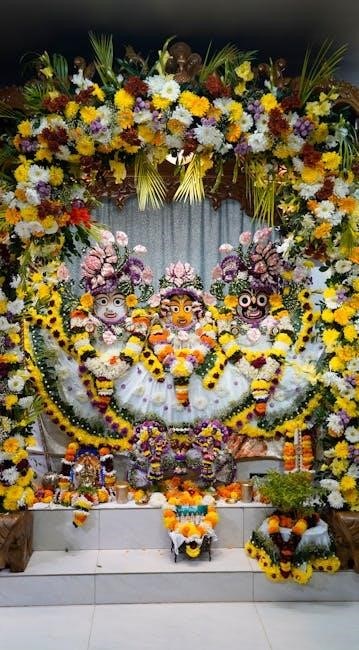
Community and Fan Contributions
Fans and communities have enriched the Deities & Demigods legacy through custom content, art, and discussions, showcasing its enduring impact on D&D culture and creative expression.
9.1 Fan-Created Content Inspired by the Book
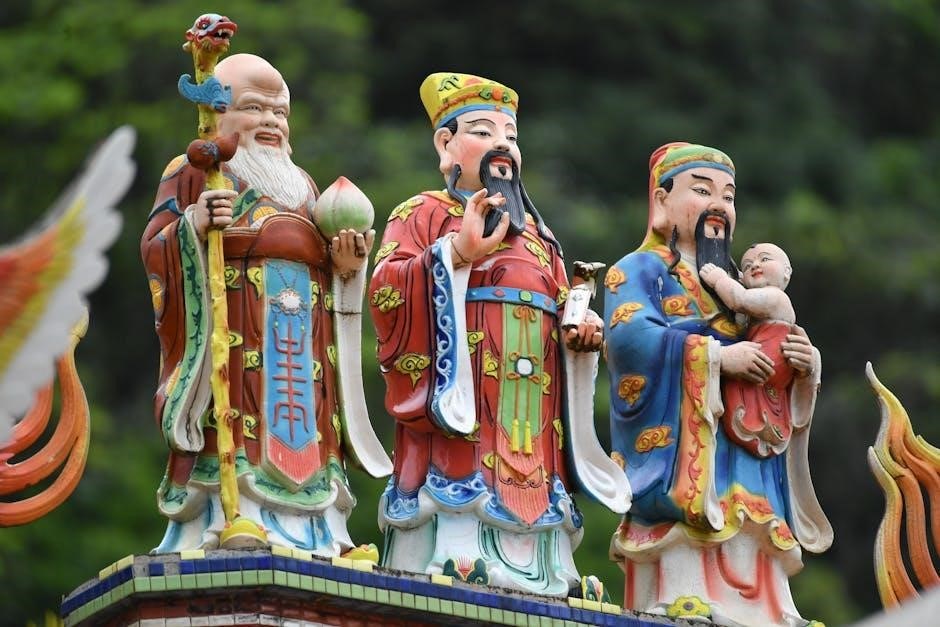
Fans have created extensive content inspired by Deities & Demigods, including custom adventures, homebrew pantheons, and character builds. Online communities share art, stories, and expansions, showcasing the book’s influence. Many draw inspiration from its unique sections, such as the Cthulhu Mythos and Melnibonéan content, crafting new divine entities and mythologies. These creations often blend traditional D&D elements with personal creativity, enriching the game’s lore. Fan-made resources are widely shared on forums and platforms, demonstrating the book’s enduring legacy and its ability to inspire imaginative contributions to the D&D universe.
9.2 Community Discussions and Forums
Online forums and communities actively discuss Deities & Demigods, sharing insights, strategies, and creative interpretations. Platforms like Reddit, D&D Beyond, and specialized forums host vibrant debates about the book’s content, its historical significance, and its integration into modern campaigns. Fans often exchange ideas on divine mechanics, character builds, and homebrew expansions inspired by the sourcebook. These discussions highlight the book’s lasting impact and its ability to inspire new generations of players and Dungeon Masters. Community engagement continues to grow, fostering a rich, collaborative environment centered around the lore and gameplay of Deities & Demigods.
9.3 Role of the Book in Modern Campaigns
Deities & Demigods remains a cornerstone in modern D&D campaigns, offering rich lore and divine mechanics. Dungeon Masters use its pantheon descriptions to craft immersive narratives, while players draw inspiration for character backgrounds and cleric builds. The book’s cosmic hierarchies and divine influence rules add depth to world-building, enabling dynamic interactions between mortals and gods. Its adaptability to various campaign settings ensures its relevance, making it a timeless resource for both veteran and new players seeking to infuse their games with divine complexity and storytelling potential.
Deities & Demigods is a foundational text for D&D, offering unparalleled depth into divine lore and mechanics. Its enduring impact ensures it remains a treasured resource for players and Dungeon Masters alike, inspiring countless campaigns and character builds. Whether for gameplay or collecting, this book is a timeless gem in the world of Dungeons & Dragons.
10.1 Summary of Key Points
Deities & Demigods is a cornerstone of Dungeons & Dragons lore, detailing divine beings, pantheons, and cosmic hierarchies. The book’s first edition famously included content from the Cthulhu Mythos and Melnibonéan series, later removed due to copyright issues, making it highly collectible. It provides mechanics for clerics, divine magic, and worship, enriching gameplay. The PDF remains a vital resource for players and Dungeon Masters, offering insights into mythological influences and cultural significance. Its legacy is evident in later D&D editions, and its digital availability ensures modern relevance, making it a timeless classic in the world of tabletop gaming.
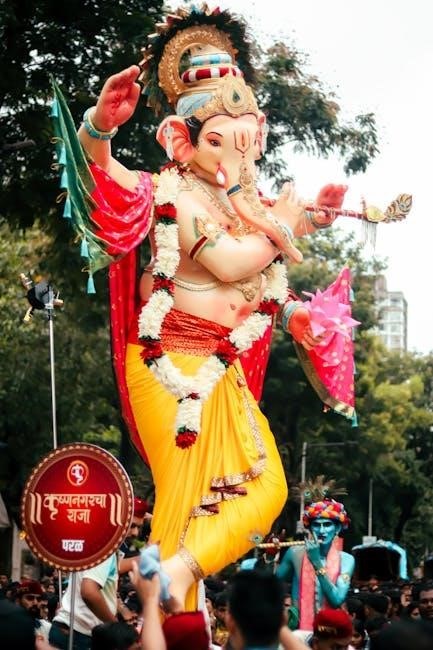
10.2 Final Recommendations for Players
Players are encouraged to explore the rich lore and mechanics in Deities & Demigods to deepen their campaigns. Clerics and divine spellcasters will find extensive resources for character development, while all players can benefit from understanding the cosmic influences shaping the game world. Experimenting with custom pantheons and divine interactions can enhance storytelling and immersion. For those interested in collecting, seeking out early editions with the Cthulhu and Melnibonéan content is worthwhile. Digital versions are readily available, making it accessible for modern players. Embrace the book’s cultural and mythological depth to create memorable and impactful characters in your D&D journey.
10.3 Encouragement for Further Exploration
Encourage players to explore Deities & Demigods to discover its rich mythological content and divine mechanics. Delving into diverse pantheons and cosmologies can enhance character development and storytelling. Early editions, featuring the Cthulhu Mythos and Melnibonéan sections, offer unique historical insights. Players are urged to download the PDF, engage with online communities, and experiment with custom pantheons, enriching their campaigns and fostering creativity in their role-playing experiences. This exploration will deepen their understanding of D&D’s lore and mechanics, making their gaming journeys more immersive and rewarding.
Additional Resources and References
Explore Deities & Demigods through online platforms like Scribd, 4shared, and GitHub, offering free PDF downloads and related D&D sourcebooks. Join forums and communities for deeper insights and discussions.
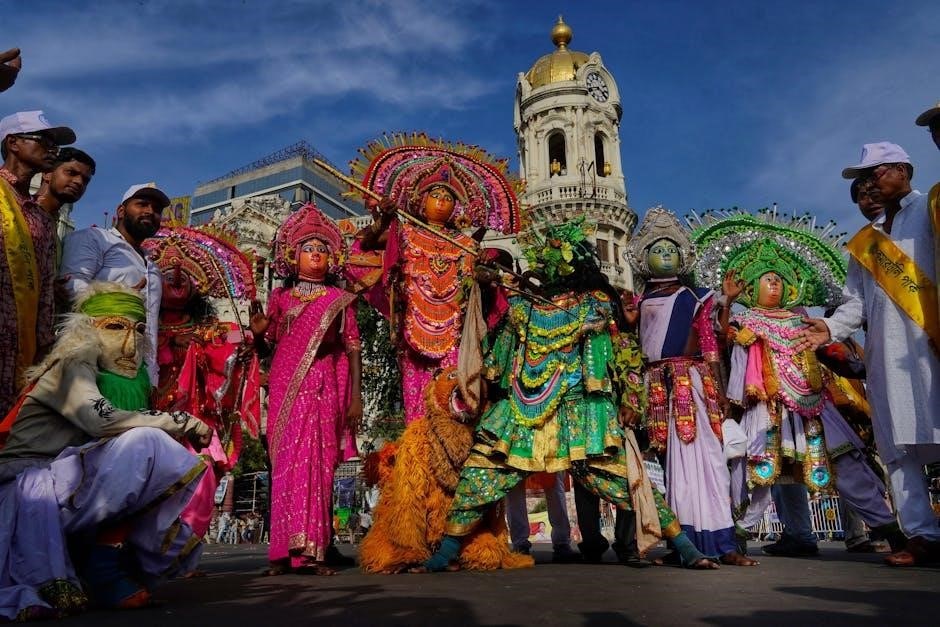
11.1 Related D&D Sourcebooks
Several D&D sourcebooks complement Deities & Demigods, including the Player’s Handbook II, Tome of Battle: The Book of Nine Swords, and Epic Level Handbook. These books expand on character creation, martial and divine combat, and high-level play. Additionally, Dragon Magic and Unearthed Arcana provide supplementary content for spellcasting and divine mechanics. For deeper lore, Monster Manuals and Faiths & Pantheons are excellent resources. These sourcebooks enhance gameplay and narrative depth, offering players and DMs a richer understanding of deities and their roles in D&D campaigns. Many are available as free PDF downloads online, making them accessible for enthusiasts.
11.2 Online Communities and Forums
Online communities and forums are vibrant spaces for discussing Deities & Demigods. Platforms like Reddit (e.g., r/LFG and r/DnD) and D&D Beyond host lively debates and strategies involving divine lore. Fans share homebrew content, character builds, and campaign ideas inspired by the book. Sites like Scribd and 4shared offer PDF downloads, fostering accessibility. These forums also highlight the book’s cultural impact and its role in shaping D&D’s spiritual and mythological dimensions. Engaging with these communities provides insights into how players adapt and reinterpret the divine elements in modern campaigns, keeping the legacy of Deities & Demigods alive and evolving.
11.3 Recommended Reading for Deeper Understanding
For a deeper dive into Deities & Demigods, explore supplementary texts like Tome of The Cleric and Gods List, which expand on divine mechanics and pantheons. The Book of Vile Darkness and Fiend Folio offer complementary insights into darker aspects of divine influence. Additionally, works by Michael Moorcock and H.P. Lovecraft provide context for the Cthulhu Mythos and Melnibonéan sections. The Deities and Demigods 3.5e PDF on Scribd is another valuable resource for understanding divine hierarchies and gameplay mechanics, ensuring a comprehensive exploration of the subject.
